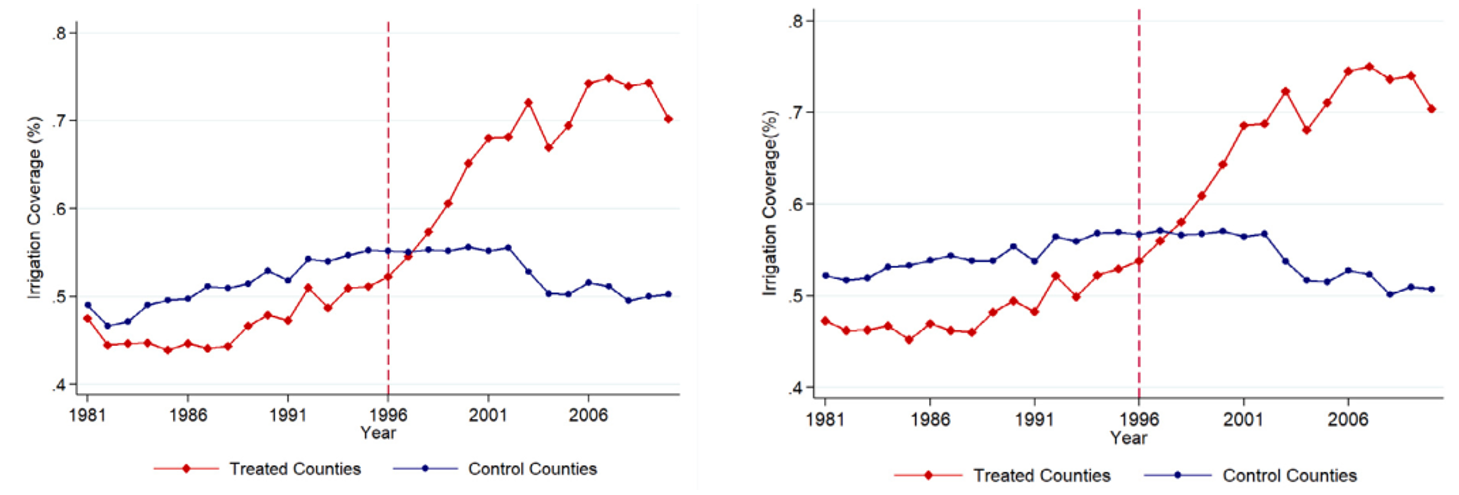
An irrigation expansion project in China serves as solid evidence for effective climate change adaptation
The looming spectre of climate change has cast a formidable shadow over the world's agriculture sector, rendering it increasingly vulnerable to unpredictable shifts in weather patterns. As the stakes grow, the need for targeted adaptation measures becomes paramount. Farmers all over the world have modified agricultural inputs, including labour, cropland, pesticides, and growing seasons, in an effort to alleviate the effects of climate change (e.g. Jaganani et al. 2020, Aragón et al. 2021, Cui and Xie 2021, Cui and Zhong 2024, Cui and Tang 2024). Nonetheless, policymakers face challenges in determining which adaptive measures should be universally promoted due to a lack of sufficient knowledge about the specific effectiveness of these measures in mitigating the impacts of climate change. While broader estimates of overall adaptation effects have garnered attention, a critical gap remains—the exploration of specific adaptive instruments (e.g. Mendelsohn et al. 1994, Burke and Emerick 2016, Chen and Gong 2021, Heutel et al. 2021). Amidst these challenges, our recent research (Wang, Zhang, Chen and Zhang 2024) introduces how a specific adaptation measure—irrigation expansion—can play a pivotal role in mitigating the impacts of climate change on agriculture.
Background
Our study focuses on China, where a sweeping irrigation expansion project initiated in 1996 serves as a case study for effective climate change adaptation (The State Council of China 1996). The backdrop of this transformative initiative lies in the decisions made during the Central Rural Work Conference of 1996, where subsidised loans were earmarked annually to bolster irrigation expansion. Concurrently, the establishment of 300 piloting counties for irrigation construction marked a concerted effort by the Chinese government to achieve food self-sufficiency, aligned with the broader goal of grain self-sufficiency.
The study draws on thirty years of meticulous county-level agricultural production data (1981–2010) and fine-scale meteorological data, presenting the first large-scale causal evidence on a specific adaptation mechanism in China's agriculture sector. The research zeroes in on the adaptive capacity of two pivotal grain crops, corn, and soybeans, collectively occupying over 20% of China's cropland. Not only are these crops essential for producing edible oils and livestock feed, but their geographical representativeness—distributed throughout China—positions them as ideal subjects for climate sensitivity studies. The empirical analysis unfolds in three interconnected parts, each shedding light on a crucial aspect of climate change adaptation.
Temperature dynamics and agricultural response
We use the change in the temperature-yield relationship around the year of the irrigation project's implementation to estimate the overall adaptation effect. Within each period (pre-1996 period and post-1996 period), the effect of high temperature on crop yields is estimated by comparing the crop yields in a county that experienced a positive temperature shock to the counterpart in a county within the same province that experienced a negative one (Deschenes and Greenstone 2007, Schlenker and Roberts 2009). Afterwards, we compare the high temperature effect across the two periods.
The findings showcase a significant decline in temperature-related yield losses, underscoring a substantial overall adaptation effect. The impact of extreme high temperatures on corn and soybean yields from 1996 to 2010 is 40% to 50% less than the preceding period. This reduction translates into a sizeable 14.5% decrease in national corn production loss (16.2 million tonnes) and a 7% decrease in national soybean production loss (1.1 million tonnes). The temporal progression of temperature effects underscores the dynamic nature of climate impacts, cautioning against extrapolations from preceding periods that may inaccurately represent future effects.
Adaptive instruments
We then explore the impacts of different adaptive instruments by estimating the marginal adaptation effects of various agricultural inputs, including irrigation, fertiliser, machinery, and electricity using an augmented panel model with temperature-input interactions. The extent to which adaptive instruments mitigate the impacts of high temperatures is estimated by comparing the temperature-yield relationship in a county with a higher growth rate of adaptive instrument adoption to that in one with a lower growth rate. The results show unequivocally that in this context, irrigation was the sole effective input for adaptation. Increasing irrigation coverage from 0% to 100% is associated with a significant reduction in temperature-related yield loss by 25 to 28 percentage points (13 to 15 percentage points) for corn (soybean), whereas the use of fertiliser, agricultural machinery, and electricity does not show statistically significant reductions in heat-related yield losses.
How has irrigation enabled adaptation?
The primary challenge for examining the effectiveness of a particular adaptive measure is that it is usually confounded by other adaptive measures - farmers often combine various adaptive measures to moderate climate change impacts. To understand how irrigation has muted the temperature-yield relationship, we rely on a change in irrigation induced by the irrigation expansion project, which is independent of other factors, especially other unobserved adaptive instruments, which might simultaneously be changing the temperature-yield relationship in a county.
We first estimate the effect of the project on access to irrigation using a Difference-in-Differences (DID) model, confirming a strong and causal relationship between the project and irrigation coverage. Figure 1 depicts the time trends of irrigation coverage for the counties treated by the irrigation expansion project (treatment group) and counties that are not affected by the project (control group). The irrigation project has led to approximately 7 percentage-point increase in irrigation coverage on average since 1996.
Figure 1: The time trends of irrigation coverage: treated counties versus control counties

(a) Corn Sample (b) Soybean Sample
Notes: Data is missing for counties that never planted corn or soybean from 1981 to 2010. Counties that did not plant corn during the period from 1981 to 2010 have been removed from the sample, leaving a total of 2301 counties that are referred to ‘‘corn sample’’. Similarly, ‘‘soybean sample’’, which follow the same criteria, are composed of 2194 counties. 295 out of the 300 treated counties as the pilots for irrigation expansion can be observed in our data (the rest 5 treated are state-owned farms which cannot be observed in the agricultural data). The irrigation coverage is the percentage of arable land that is effectively irrigated (effectively irrigated area over total arable land area).
We then estimate the effect of access to irrigation via the irrigation expansion project on the temperature-yield relationship by comparing within-county temperature effects before and after the irrigation expansion project was implemented. The analysis reveals that the presence of the irrigation project significantly mitigated the high temperature impacts on crop yields by approximately 4.5 percentage points, with project-induced irrigation expansion accounting for about 40% of the overall adaptation effect.
Policy implications
As the world grapples with the complexities of climate change, China's experience of adaptation through irrigation stands as a beacon of hope. Our study underscores the critical role of targeted interventions, like irrigation expansion, in building resilience against climate-induced challenges. It challenges nations to reassess and tailor their adaptation strategies, emphasising the need for proactive measures to secure the future of global agriculture. In the delicate balance between human ingenuity and environmental challenges, China's agricultural revolution showcases the potential for strategic, impactful change in the fight against climate change.
References
Aragón, F M, F Oteiza, and J P Rud (2021), "Climate Change and Agriculture: Subsistence Farmers’ Response to Extreme Heat," American Economic Journal: Economic Policy, 13(1): 1–35.
Burke, M B and K Emerick (2016), "Adaptation to Climate Change: Evidence from US Agriculture," American Economic Journal: Economic Policy, 8(3): 108–140.
Chen, S and B Gong (2021), "Response and Adaptation of Agriculture to Climate Change: Evidence from China," Journal of Development Economics, 148: 102557.
Cui, X and Q Tang (2024), "Extreme heat and rural household adaptation: Evidence from China," Journal of Development Economics, Vol. 167, 103243.
Cui, X and Z Zhong (2024), "Climate Change, Cropland Adjustments, and Food Security: Evidence from China," Journal of Development Economics, Vol. 167, 103245.
Cui, X and W Xie (2021), "Adapting Agriculture to Climate Change Through Growing Season Adjustments: Evidence from Corn in China," American Journal of Agricultural Economics, 00(00): 1–24.
Deschênes, O and M Greenstone (2007), "The Economic Impacts of Climate Change: Evidence from Agricultural Output and Random Fluctuations in Weather," American Economic Review, 97(1): 354–385.
Heutel, G, N H Miller, and D Molitor (2021), "Adaptation and the Mortality Effects of Temperature Across U.S. Climate Regions," The Review of Economics and Statistics, 103(4): 740–753.
Jagnani, M, C Barrett, Y Liu, and L You (2020), "Within-season Producer Response to Warmer Temperatures: Defensive Investments by Kenyan Farmers," The Economic Journal, 131(633): 392–419.
Mendelsohn, R, W Nordhaus, and D Shaw (1994), "The Impact of Global Warming on Agriculture: A Ricardian Analysis," American Economic Review, 89(4): 753–771.
Schlenker, W and M Roberts (2009), "Nonlinear Temperature Effects Indicate Severe Damages to US Crop Yields Under Climate Change," Proceedings of the National Academy of Sciences, 106(37): 15594–15598.
The State Council of China (1996), "The State Council’s Approval of the Ministry of Water Resources, the National Development and Reform Commission, the Ministry of Finance, the People’s Bank of China, and the China Agricultural Development Bank’s ‘Notice on construction of 300 key counties for irrigation expansion during the ninth five-year plan period’," Rural Water Resource Hydropower China, 9: 3.




